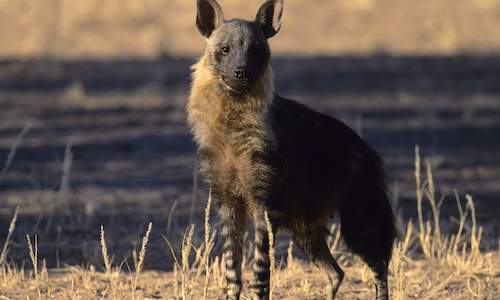Brown Hyenas Introduced to Mountain Zebra National Park
Jessica Comley, the lead researcher of the project, reported that 5 animals had been identified in photographs by July 2014.Three brown hyenas were first introduced into Mountain Zebra National Park near Cradock in December 2008, becoming the first of their kind to be released in the area. After 10 months, their collars had ceased to function and the location of these hyenas became a mystery.
In April 2014, researchers from Rhodes University set up cameras traps in 11 locations throughout the park, with the aim of finding out how big the population size is. Jessica Comley, the lead researcher of the project, reported that 5 animals had been identified in photographs by July 2014. She added that one of the photographed hyenas was one of the three that were release in 2008, and that he was still wearing his collar.
The photographs showed that the hyenas had been carrying carcasses in a westerly direction, leading to the assumption that the hyenas had set up a den in the northern section of Mountain Zebra National Park. Researchers have also considered the possibility of cubs, but no concrete evidence had been found yet.
Brown hyenas (Hyaena brunnea) historically occurred in the area but were eradicated by hunting activities in the 1800s. The three hyenas - an adult male, adult female and young female - were translocated from Mafunyane Game Reserve in the Northwest Province in November.
The hyenas spent three weeks in a boma at Mountain Zebra National Park to allow them to acclimatize to the local conditions and the predator-proof fencing before their release. All three hyenas were collared to allow park rangers to track them via telemetry and satellite technology. This enabled the rangers to monitor the movements of the hyena to check whether they are settling down well in their new home and to determine what habitat they frequent.
The hyenas play an important role in the ecosystems in Mountain Zebra National Park in their role as scavengers that feed on dead material. The park's cheetah, introduced in 2007, provide ample prey carcasses for scavengers such as hyena. The hyena also feed on insects, fruit and small mammals such as rodents, although predation makes up only about 6% of their diet.
A typical brown hyena population lives in small clans of related individuals led by an alpha female. When not at the clan's den, brown hyenas are usually solitary foragers. The brown hyena is listed as a Protected Species on the IUCN Red List.
Reference
Zululand Observer
https://zululandobserver.co.za/47207/study-sheds-light-hyenas/

Brown Hyena [Hyaena brunnea]. This creature has pointed ears and striped legs with a dark brown to black shaggy coat, white shoulders and ne...
more
